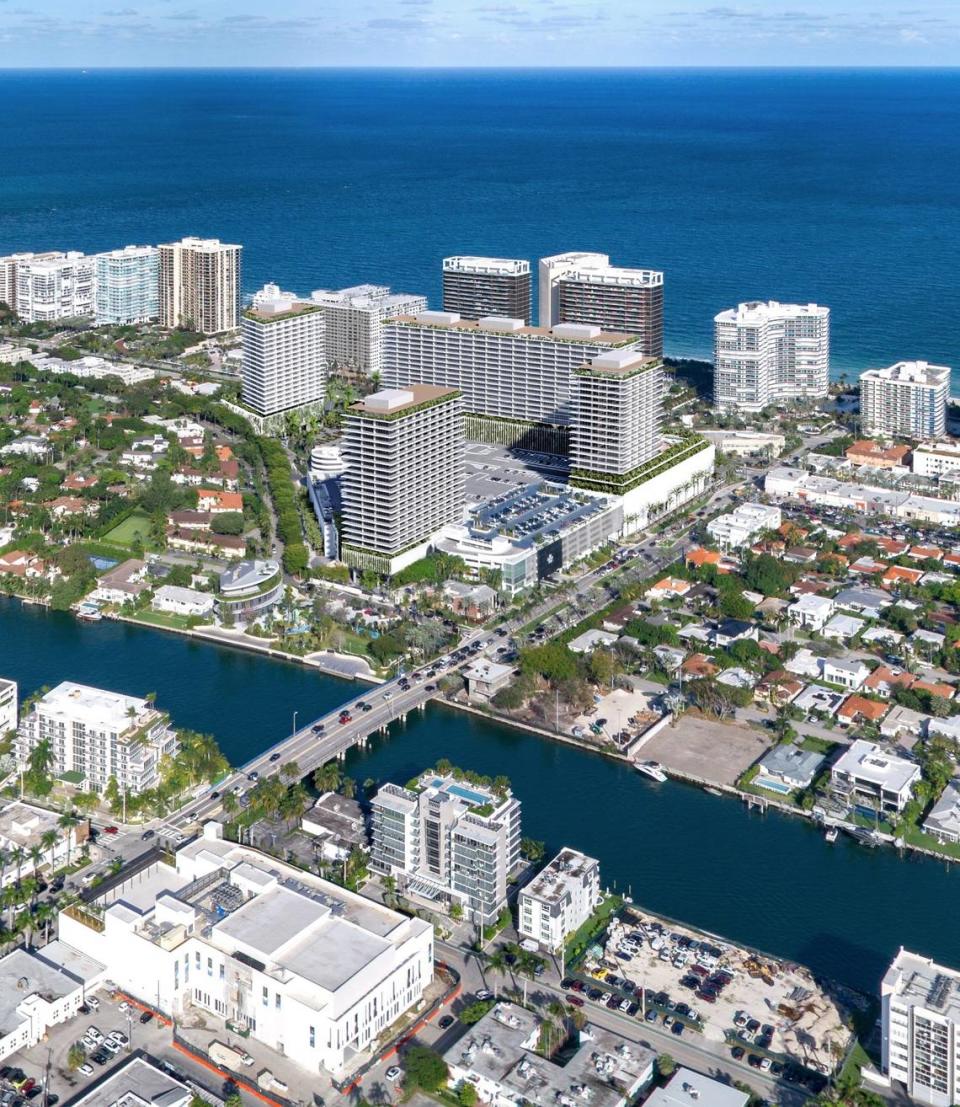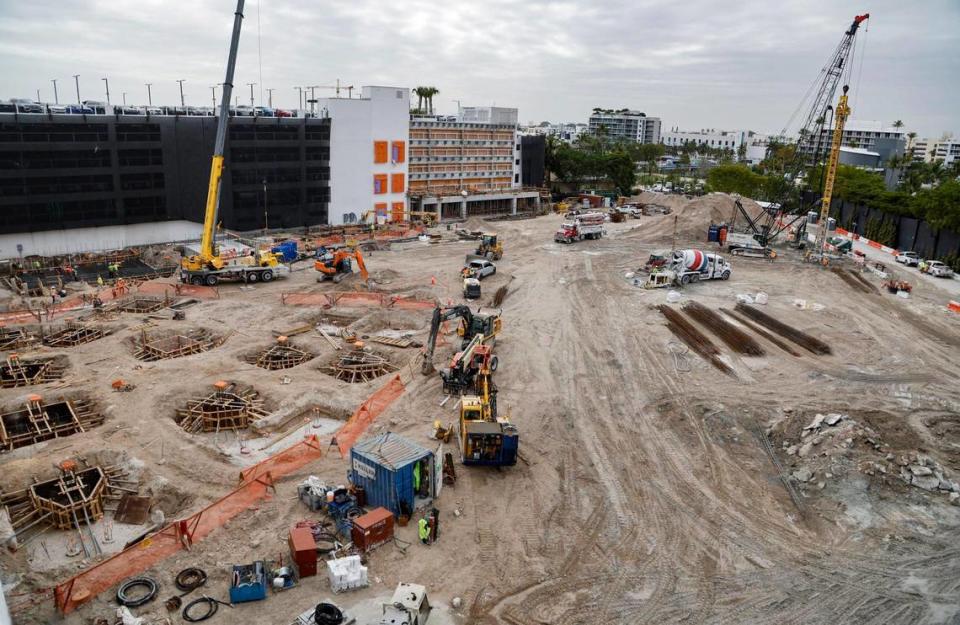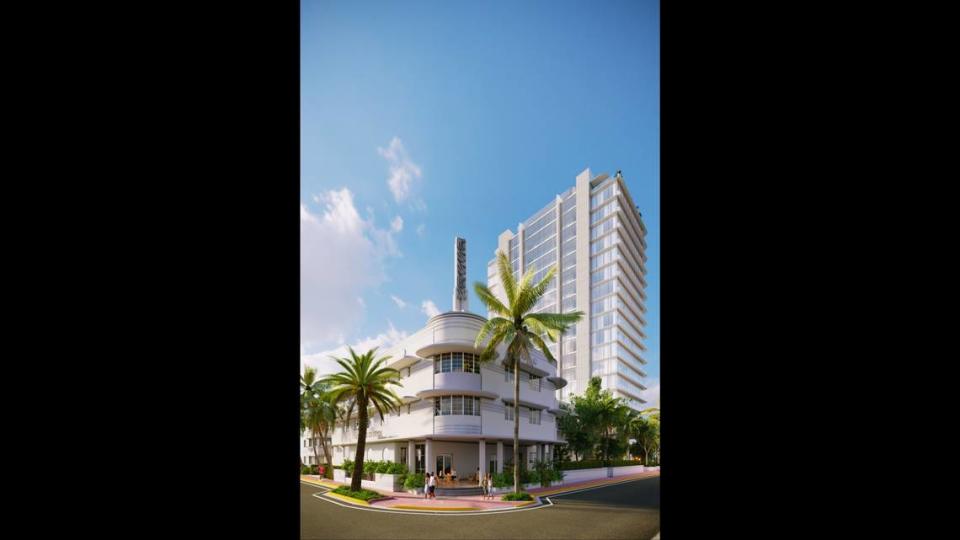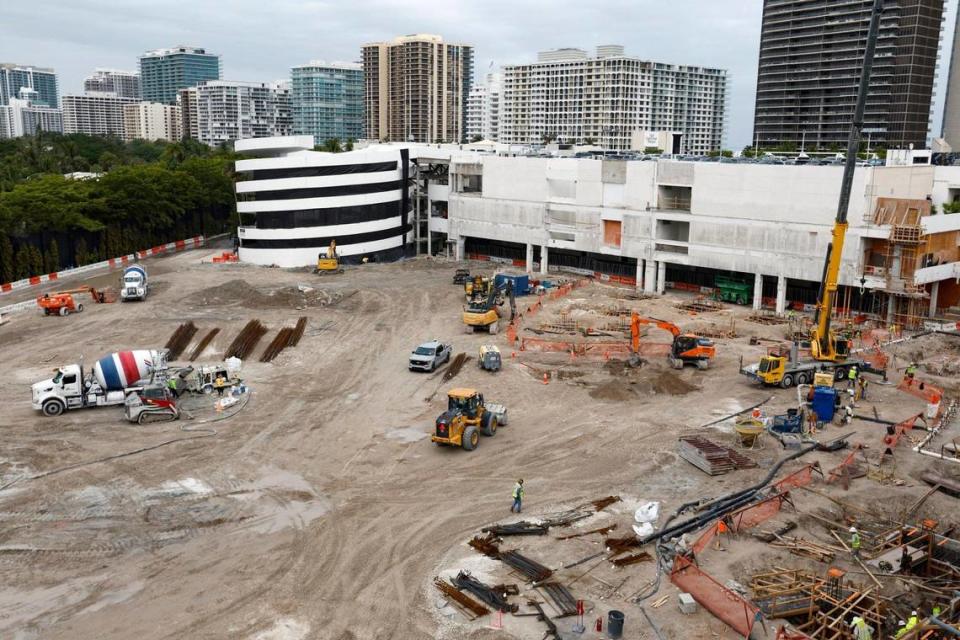To get around size limits, Bal Harbour Shops plans workforce apartments at luxe mall
Three years after local voters roundly rejected a bid by Bal Harbour Shops to expand by building upwards, the luxury mall’s owners are turning the tables on their nay-saying neighbors. They now plan to put up a tower billed as workforce housing alongside its posh designer shops by using Florida’s controversial new Live Local Act to get around objections by voters and elected officials.
In invoking the 2023 law, which overrides local zoning rules to encourage developers to build dense housing affordable to middle-income people, Whitman Family Development is aiming to get what the company has long sought, only to be thwarted repeatedly by objecting residents in the tony beachfront village of Bal Harbour — the ability to add luxury hotel and residential development to a mall long effectively limited by strict local rules to three stories.
On Tuesday, the family firm filed an application with the village for a massive expansion that would add two million square feet and four towers of up to 27 stories on the 18-acresite. The plan includes a 70-room boutique motel, nearly 46,000 square feet of new retail space, and 600 residential units.
To trigger the zoning-busting features of the Live Local Act, the Whitman plan calls for 240 rental apartments, or 40 percent of the total, to be leased at rents affordable to people earning up to 120 percent of the area median income, legally defined by Miami-Dade County as households making up to around $90,000 a year. The rest would be upscale condos or apartments.

Under the Live Local Act, the village council is obligated to approve a qualifying application administratively — that is, without public hearings, votes or review where residents and elected officials could register objections or try to block or modify developers’ proposals. One reason for that strategy is the fact that zoning rules in many communities effectively block the development of affordable housing.
Whitman company CEO Matthew Whitman Lazenby said the proposal does precisely what the Live Local Act calls for by introducing badly needed “attainable” housing to Bal Harbour, which he called “a major achievement.”
”Yes, Live Local Act allows developers like me to borrow height and density to promote affordable housing development,” he said in an interview. “That’s the whole purpose of the act.”
But the Whitman proposal drew swift, sharp criticism from Bal Harbour Mayor Jeffrey Freimark, who said it’s already led to an uproar among residents as word gets out.
‘Thunderbolt’ announcement
Freimark said he feels deliberately ambushed by Whitman Lazenby. The town didn’t learn about their plan until the end of a scheduled meeting with Whitman officials about their longstanding desire to add a hotel to the shopping complex. When Freimark asked if they planned to sound out residents, he said he was told there was no need to because the company had already filed its application.
“That was a thunderbolt,” Freimark said in an interview. “Was I surprised, pissed off? Yes, I can say that absolutely. There was absolutely no advance discussion or knowledge. It was, to use a term, a surprise attack. It’s clear this is going to create a lot of consternation and unrest. People are up in arms. This is going to create a lot of ill will.”
The council scheduled a discussion of the proposal for its Jan. 16 meeting, but it’s unclear at this early stage what if anything the city can do about the application.

Opened in 1965 by the late Stanley Whitman, who also helped found the village, Bal Harbour Shops has expanded several times and today boasts some 100 luxury retailers like Chanel and Gucci and several high-end dining spots in an al-fresco setting. It draws an international clientele that has made it one of the world’s top grossing shopping malls per square foot. The mall is still controlled by the Whitman family.
Their proposal highlights both the apparently insatiable appetite for luxury goods by the wealthy elites now flocking to Miami, and some controversial aspects of the Live Local Act. The law drew praise from housing advocates when it was approved in a broadly bipartisan vote by the legislature last year.
However, it has since prompted a fierce backlash by residents and officials in some municipalities, including Doral and Miami Beach, faced by proposals for outscaled development under the act. Some critics complain that the law entails a financial windfall to developers with a relatively small dent on the state’s affordable housing crisis, which is centered on low-income families who will not benefit from the housing it produces.
At the same time, most affordable housing developers do not qualify for one of the chief features of the law — property tax reductions, which the bill’s authors designed to entice developers who focus on market-rate projects. Whitman Lazenby said his company is not applying for tax benefits.
One Bal Harbour civic leader said she and members of the residents’ association she leads believe the shops’ proposal uses the workforce housing element as a wedge to force approvals for development the town and its voters would not otherwise approve.
“I think they are horrified. They feel like the Bal Harbour Shops is trying to do an end run around the voters,” said Neca Logan, president of the Bal Harbour Civic Association, which represents residents of a low-rise neighborhood north and west of the mall. “The Bal Harbour Shops is relentless in its pursuit of what it wants. They clearly are not good neighbors.”

The Whitmans’ Live Local application comes as the mall is in the midst of a multi-year, $500 million expansion project approved in 2017 after a decade of often-contentious votes and negotiations between village officials and the mall owners. The project, which Freimark said is running two years behind schedule, has not improved neighbor’s view of the mall’s owners. Logan said residents are already fed up by the years of noise and traffic disruptions, and have no appetite for even more years of construction at the site.
90 percent no vote
Four years into work on the new expansion wing and parking garage, the Whitmans asked village voters to overturn a 2006 referendum that limited building height on mall property and required voter approval to build taller. But they suffered a stinging defeat when 90 percent of voters cast a “no” ballot.
“I mean, 90 percent is not a little margin,” Logan noted dryly. “And that’s in a referendum they asked for and paid for.”
But the Live Local Act, approved by the state legislature last year, provided a way out for the Whitmans and their veteran land-use attorney, John Shubin.
The 40-percent workforce housing commitment opens the door for the developers to bypass a set of stringent zoning restrictions enacted by Bal Harbour voters and elected officials over the years to limit the size and height of the mall to safeguard the low scale of the affluent town’s mostly residential west side.
Whitman Lazenby touts the addition of workforce housing to the mall would reduce notorious gridlock along Collins Avenue and 96th Street, where the mall is located. That’s because some workers who now commute by car to the mall could live instead at the planned workforce housing tower, he said.
Questions on affordability
The workforce units, however, would likely remain out of reach for most mall employees. Rents would not be set until the tower opens, but the income target required to afford it now sits at nearly six figures a year for a household of four, according to Miami-Dade County figures.
Whitman Lazenby stressed that the workforce housing, which would occupy a tower along 96th Street, would be built first and would be indistinguishable in appearance from the outside from the design of the rest of the complex and the planned companion towers. The Whitmans hired SOM, a leading international firm based in Chicago, to design the project.
“We want to make sure no one can differentiate that tower from the rest. I want every square inch of it to be top-notch,” he said.
Whitman Lazenby also suggested local opposition to the plan is disingenuous because the village has approved buildings as tall as 320 feet across Collins along the beach, including the St. Regis hotel. And he said the only place suitable for workforce housing in the municipality is the shops property because it makes up the entirety of the town’s commercial district. Live Local applies only in commercial and industrial zones.
“Live Local Act was created to solve this problem. It only applies in limited areas. In Bal Harbour village, the only place is the Bal Harbour Shops,” he said, while adding. “I’m saddened to hear a lot of residents aren’t thrilled by our plans.”
By allowing denser, profitable mixed-use development, the Live Local Act seeks to make it financially attractive for developers to build workforce housing that’s effectively subsidized by revenue from the rest of a project. While some land-use experts have said the likely result would be to foster development of mid-rise projects, developers behind a series of high-profile proposals under Live Local have sought to supersize buildings to capitalize on the law.
In Doral and Miami Beach, where the owners of the famed Clevelander Hotel in the city’s Art Deco district proposed redeveloping the historic property with a tower far taller than anything in the vicinity, intense pushback from residents and elected officials prompted the developers to significantly downsize their initial plans. They key was a technical loophole in the drafting of Live Local that did not require local officials to provide the needed square footage, a measure known as floor-area ratio, or FAR, to allow developers to actually build at supersize scale.

The Bal Harbour shops proposal seeks a significant increase in FAR that’s not allowed under current village zoning, meaning it might not win approval under the current version of Live Local, though Whitman Lazenby and Shubin say their plan meets all requirements.
Closing some loopholes?
Proposed fixes to the law filed this current legislature session seek to remove that option for local regulators but it would also add some height restrictions that could aid municipal officials seeking to limit the impact of Live Local projects. Whitman officials say they believe their plan would not be affected by the fixes under consideration.
But Freimark, the mayor of the village of just under 3,000 people, said that’s an open question. He also noted that the expansion now underway is governed by a detailed development agreement between the village and the Whitmans, and raised the possibility that the legal document restricts what the mall owners can build.
The expansion was approved only after several controversies and prolonged negotiations, including the Whitman’s purchase of the Bal Harbour Church by the Sea, which they demolished after an effort by preservationists and some congregation members to have it declared a historic landmark failed. Another was a property swap with the village to add its adjacent municipal hall to the mall property, in exchange for the Whitmans’ providing land and erecting a new municipal building and creating a new bayfront park, among other public benefits worth an estimated $100 million to $120 million.

Freimark said he was expecially disappointed by the Whitmans’ plan because town officials have sought to work cooperatively with the mall owners.
“We as a council have really worked with them in the past. We have clearly acted, I think, in good faith,” he said. “I will go into this open-minded and understanding of the regulatory requirements and the Live Local Act. But the community has spoken loudly and vociferously about protecting that height limitation.”
Freimark said he foresees significant impact and disruptions for years to come if the project, which would be built in phases over several years, comes to pass.
The plan would wedge the towers into the mostly built-out property in part by tearing out some of what’s there now, though most of the work won’t take place for years, Whitman Lazenby said.
The workforce tower would be on 96th Street, built atop an existing parking garage at the west side of the mall.
The hotel tower, which would not be developed anytime soon, would require demolishing the building housing Saks Fifth Avenue, which has been in litigation with the Whitmans. One of two market-rate towers would occupy a parking lot alongside the front entrance of the mall on Collins Avenue, and the other would eventually be built in a parking lot next to the Neiman Marcus building.

